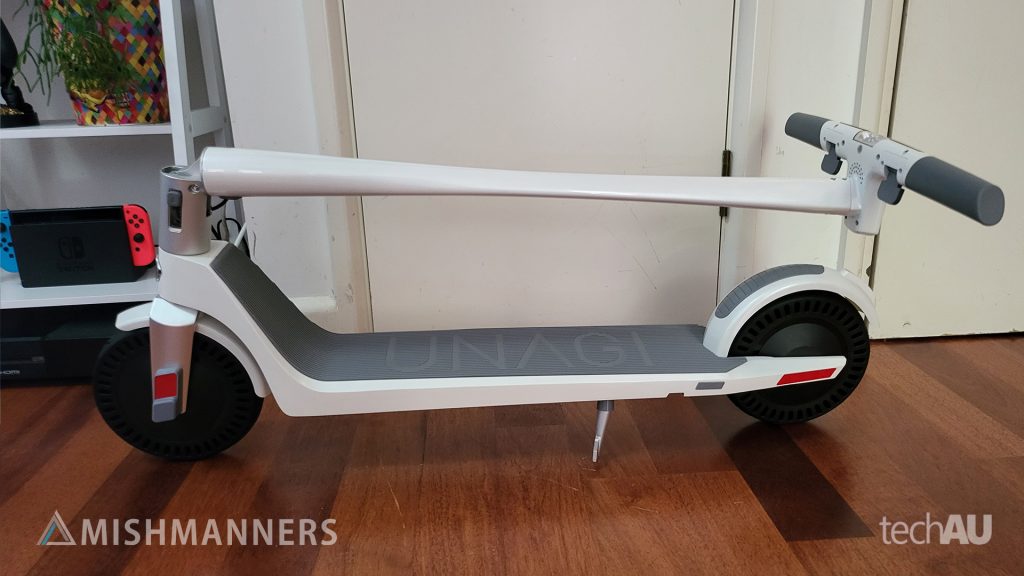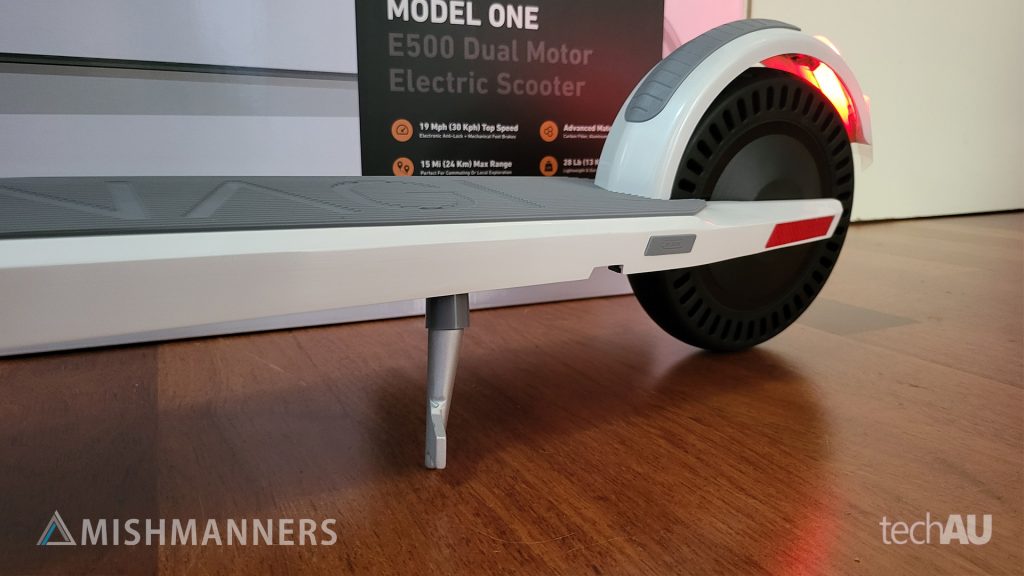Electric scooters are fast coming popular as an alternative transport method. They are one of the fastest and cheapest ways to get around a city. Not to mention the ability to avoid crowded public transport when people are still cautiously being socially distant.
Even our own Jason Cartwright embraced electric scooters on his recent trip to the Australian Grand Prix. As these devices are becoming more accepted, the question isn’t whether one should buy an electric scooter, but which one. We got in touch with Unagi to try out one of their most popular models, the Unagi E500.
I really put this scooter through its paces. At the time of writing, I’ve ridden 40 miles or 64 kilometers.

Out of the box
The Unagi E500 comes with everything you need right out the box. The scooter I unboxed had some charge on it (about half) so I could ride it right away if I wanted. Although there is a tiny bit of assembly required. Riders need to connect and fix handlebars before taking the scooter out for its first spin. This process was very quick and super easy.


Inside the box, there’s a charger included and this is also easy to use. Instructions are included, although I didn’t really look at these. As you’ll see below, everything was relatively intuitive and so simple to get started.
Charge time and distance
The two biggest questions when it comes to electric scooters, is how long does it last, and then by extension, how quick is the charging. The Unagi E500 has a publicised range of 25 kilometers (15.5 miles). Realistically however, it’s difficult to achieve this range. Range is dependent on many factors. These include terrain, rider weight, and inclines. The Unagi E500 also has various modes as you’ll see below. Each mode will give you a different range. For example, if you use full power, you’re obviously not going to get as much range as if you use the eco mode.
That said, I had the scooter on full power, relatively flat terrain, and I’m pretty light. I was easily able to get 15km out of the scooter. The cool thing about the Unagi too is that speed doesn’t decline with battery drainage. Some scooters gradually get slower and slower until the power is completely gone. For example, if you have half battery left, you’ll only get half the speed. The Unagi however retains its speed until nearly all the battery is drained.
Charging is also pretty convenient. I forgot to charge it one more and I was able to charge it enough in 30mins to make to my 10km round trip. However, full charge takes about 4-5 hours. I have gotten in the habit of setting an alarm and remembering to charge my scooter each night before I take it out the next day!
Portability
Weighing just over 12kg, the Unagi E500 is one of the lightest scooters out there in its class. It’s super easy to fold up, carry around, and transport. I carried mine down stairs, on trams, onto trains, and stashed in the back of the car. I had no issues picking up the scooter and effortlessly carrying it down my apartment stairs, unlocking doors with one hand as I went.
The folding mechanism is super easy to use. The stem effortlessly unlocks once pressed in and folds down nicely.


There’s also a stand on the scooter for when you need to make a quick stop. The stand is relatively sturdy, however it’s not very big. Thus if you have the scooter on a slight incline, it won’t stay up. It works really well on flat ground so the floor of my apartment is great.


Unagi E500 Modes
The Unagi E500 features a few different modes. These were super intuitive and I didn’t even need to get the manual out! Double clicking the middle button (power button) on top of the scooter toggles on or off the second motor. Having both motors running means you’ll have more power, but less battery life. Aside from choosing between one and two motors running, the scooter has three main modes; 1, 2, and 3. Each mode unlocks more power, making the scooter faster off the mark. The modes can be toggled between by long clicking the right hard button.
The buttons do a few other things too. A semi-long hold of the power button turns the headlights on/off. A quick press of the right button toggles between trip distance travelled and total mileage. Quick pressing the left activated a ‘horn’ and holding both outside buttons allows riders to toggle between miles and kilometers.
Aside from having to look up how to switch into kilometers, everything else was intuitive enough to figure out within about 30 seconds.
Lights, display, and handlebars
I really like the lights and display on this scooter. The modes above can be seen on the display on top of the scooter. The display shows speed, mode, lights, and battery. It’s convenient to glance down at the scooter and see how fast you’re going on the fly. Having the battery front and center is really useful. It’s a sleek, minimalist design and really fits the overall look of the scooter.


One of the things that I’m still undecided about is the handlebars themselves. The material used is smooth and rubbery. This is good if you don’t like super grippy handlebars, but it can be a little slippery in the wet; although you shouldn’t be riding in heavy rain! The handles aren’t fully rounded either. They are more oval shape instead of circular. It’s more a different feel rather than simply good or bad.
There’s also front and rear lights. The rear light is always on and the front headlight can be toggled on or off. There’s plenty of light thrown on so riding at night isn’t an issue.


I also like the little details, like this cool chrome-like logo on the front.


Airless tires
Probably one of the biggest decisions when it comes to buying an electric scooter is air-filled (pneumatic air tires) or airless (solid pneumatic tires). Each have their pros and cons. Air-filled tires are more absorbent, often leading to a comfier ride. Airless tires on the other hand are great as they don’t puncture, don’t require pumping up, changing tubes, or other maintenance.
If you hate maintenance then the Unagi E500 is perfect. It features solid tires and therefore no maintenance on the wheels is required. I however, don’t mind a little bit of maintenance work as the pros for me far outweigh the cons.
Being a lighter rider (yes, I only weigh 50kg), riding the Unagi with solid tires means I feel every little bump. Instead of just hanging onto the scooter and cruising, I need to ‘ride’ it a little more. This means bending my knees to absorb the usual road bumps, and shifting my weight to adjust to the terrain.


Each to their own on this aspect of electric scooters but I definitely prefer the slightly smoother rider of air-filled tires. Although I have much appreciated not having to pump up my tires every couple of weeks!
Horn?
Okay the horn on the Unagi electric scooter is probably one of the weirder things. A bell or horn is mandatory on any road vehicle as it’s used to alert pedestrians and other riders of your presence. Thus, it’s required by law in most countries. Most bikes that a bell with a ringing sound. This has become a distinctive and recognisable sound in most cities. The bell on the Unagi however is a very different.
Rather than having a “ringing” sound, it has a short blast, electronic beep. While it’s relatively loud, it’s so short that I can go unnoticed. It’s also not a sound that most people would associate with a ridable vehicle. As this is the case, I’ve resorted to using my voice to alert others of my presence.
E500 vs. E350
Whilst we have the E500 to review, the E350 is very similar. This is however one key difference. The E350 is a single motor electric scooter. The E500 has dual motors. This additional motor means the E500 is a bit more powerful than it’s cheaper counterpart. Whilst the E350 has a slightly bigger motor (350W), the E500 has higher overall power (2 x 250W motors).
Both scooters have the same top speed, so if you’re looking for top speed, there’s no difference. The biggest difference you’ll notice is the torque or the power. Having two motors means the scooter has higher torque, or more power. This means riders will go faster, quicker. Both scooters will get you to 25km/hr, but the E500 will get you there quicker.
More power also means more “grunt”. Riders will notice the E500 will be able to up hills more easily than the E350. I tried out the E500 on all the steep hills in Melbourne and had no problems riding to the top at a reasonable speed. No more jumping off a scooter and pushing for me.
Finally, since the E500 has an extra motor, the electric scooter is a tad heavier. The E500 weighs in just over 12kg, and the E350 is a mere 11kg. This extra kilogram probably isn’t too much to worry about, but if you’re looking for something for the kids, or a light rider, the E350 will more than suffice.
Where to buy
Both the Unagi E500 comes in four different colours, Matte Black, Sea Salt (white), Cosmic Blue, and Scarlet Fire (red). The E350 only comes in Gotham Grey. According to a new post from Unagi, there’s also a Moss (green) colour available. Both scooters can be purchased from retailers such as JB Hi-Fi. You can pick up the E500 for $1699 AUD and the E350 for $1299. The difference really comes down to whether you want to spend an extra $400 to get a second monitor is higher power.


Regulations in Australia
Riders in Australia need to remember to ride with caution and always wear a helmet. Each state and territory has different rules and regulations on where you can legally ride an electric scooter and how fast. Check the laws in your local area before choosing to purchase a scooter. Read more about the electric scooter trials in Melbourne and Perth.
